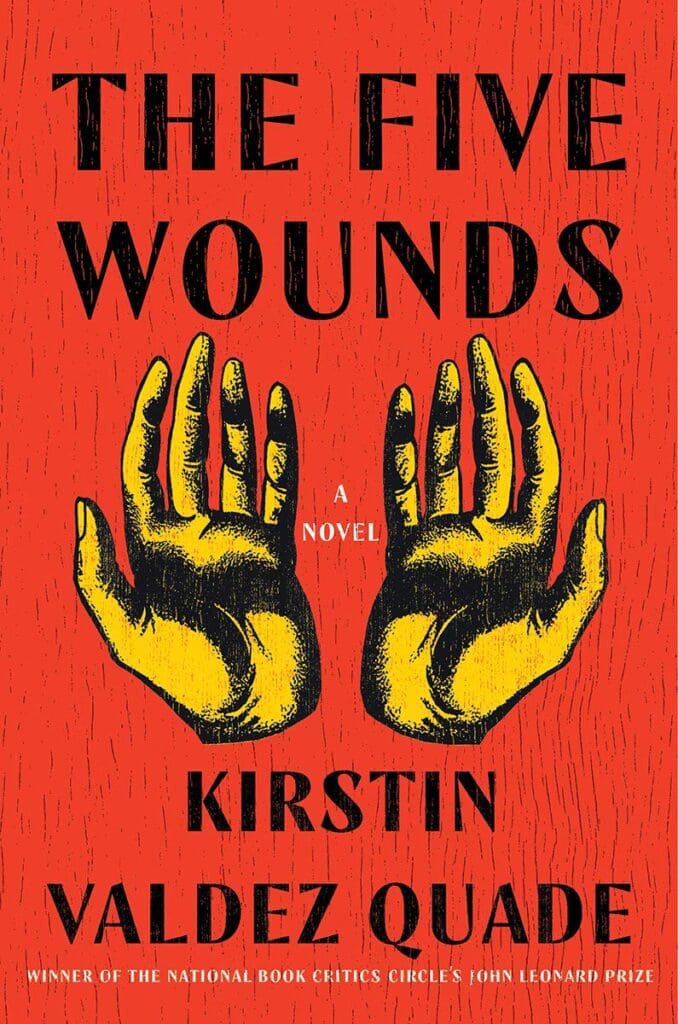Amadeo Padilla is preparing for his starring role as Jesus in a Good Friday procession when his estranged 15-year-old daughter, Angel, shows up on his doorstep—eight months pregnant. So begins Kirstin Valdez Quade’s exceptional first novel, The Five Wounds (416 pages; Norton), which she arranges in three sections according to the Church calendar: “Holy Week,” “Ordinary Time,” and “Lent.”
We begin in Holy Week, with Amadeo, adrift. He and his daughter have been estranged, and we learn that for weeks at a time, he has forgotten that he has a daughter at all. He is in his thirties, unemployed, lives with his mother, and has always felt ill-equipped for parenthood and life in general. The Passion sequence held every year in this part of New Mexico is, he believes, his opportunity for rebirth, to make meaning of his life.
He needs to know…if he can get up there in front of the whole village and do a performance so convincing he’ll transubstantiate right there on the cross into something real. He needs to know if he can face that pain, straight on and with courage, without dodging it…Total redemption in one gesture, if only he can do it right.
On Good Friday, in the rush of the moment, Amadeo demands to be crucified—actually. He cries out for “the nails.” Quade describes it this way: “They hold the tip of the nail against his palm, and he feels it there a moment, light as a coin, and then they pound it through.”
Almost immediately, the story rushes us (along with Amadeo) to the ER. The dissonance is acute: the brutal, mystical ritual contrasted with the dull, if dire aftermath.
The doctors are taking forever. He’s been sitting under the fluorescent lights in this plastic chair bolted to the floor—leaning forward so as to protect his scourged, tender back—for nearly two hours. Through the automatic doors, the sky is already pink.
“Hey,” he tells a nurse rushing past in scrubs printed with Easter eggs. “How long’s it going to be? Because this is really serious.” He indicates his hands, but the nurse regards him with only the barest tightening flicker around her mouth, then rushes on, consulting her clipboard.
Amadeo is bandaged up, sent home. We move into Ordinary Time, the majority of the book, so that structurally and conceptually, Quade examines what happens after Holy Week. Amadeo resumes life with his mother, his daughter, and now his grandson. What does the crucifixion—both Amadeo’s and Christ’s—have to do with everyday life? How should a person understand their suffering when it isn’t staged? As his alcoholism reawakens, Amadeo wonders, “What’s the point of being sober if no one notices?”
His core conflict is subtly modern. Beyond the material concerns of unemployment and excessive drinking, it’s a dogged link between performance and redemption, so that any potentially fulfilling experience instead feels hollow, made for consumption. Beautifully, Quade draws out the contest between the outer and inner life, validation versus something deeper and less quantifiable.
Throughout the book, two planes intersect, the vertical plane of heavenward abstraction (faith, Christ, redemption), and the horizontal plane of daily life (hospital visits, school presentations, diaper changes; trying to get a job, trying to raise a child, trying not to drink).
Quade, most known for her masterful short stories (one of which inspired this novel), writes in a vivid, entrancing present tense that lends urgency to even mundane tasks. She treats everyday life with reverence, such that, all together, The Five Wounds becomes epic in its devotion to detail and the emotional experiences of its characters. Readers will benefit from taking their time, dwelling in the scenes Quade crafts with depth and care.
It’s telling that she concludes in “Lent,” a season of intentional deprivation. Lent anticipates renewal, but is not gratified by it, and it’s only here that Amadeo begins to see that his redemption lies not in the expunction of his weaknesses but in the deeper understanding that “for someone with his particular weaknesses, performance is a distraction.”
The Five Wounds invites readers into that same experience: to move from distraction to attention, longing to awareness. To take in the gift of life—though challenging, wounded—before us, rather than looking past it, at some hazy glory on the horizon.

